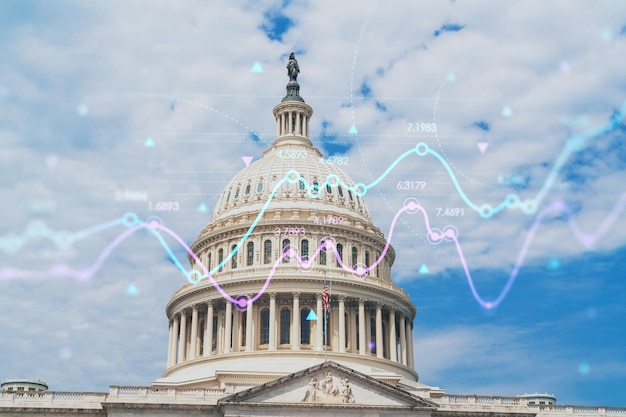2025 Federal Budget: Impact on Social Programs in the US

The proposed 2025 federal budget is expected to significantly impact key social programs in the US, potentially altering funding levels, eligibility criteria, and service delivery across various sectors like healthcare, education, and social security.
Understanding how will the proposed 2025 federal budget impact key social programs? is essential for every citizen. Let’s analyze possible scenarios about the most updated federal budget.
Decoding the 2025 Federal Budget: An Overview
The federal budget serves as a financial blueprint for the United States, outlining the government’s spending priorities for the upcoming fiscal year. Understanding the proposed 2025 budget requires examining its key components, including revenue projections, discretionary spending, and mandatory spending.
This budget significantly determines how resources are allocated across various sectors, influencing everything from national defense and infrastructure to social programs and research initiatives. The implications of these decisions can be far-reaching, affecting the lives of millions of Americans.

Key Components of the Federal Budget
The federal budget consists of several critical elements that dictate the flow of funding. Revenue projections estimate the amount of money the government expects to collect through taxes, fees, and other sources. Discretionary spending refers to the funds allocated annually by Congress through the appropriations process. Mandatory spending includes programs like Social Security and Medicare, which are governed by existing laws and not subject to annual appropriations.
- Revenue Projections: Estimations of incoming funds influence the available resources for spending.
- Discretionary Spending: This is subject to annual congressional decisions and covers a wide range of programs.
- Mandatory Spending: Governed by existing laws, it includes entitlements and other mandatory obligations.
Understanding these components is crucial for assessing the potential effects of the budget on social programs and other important sectors.
In essence, the 2025 federal budget requires a thorough analysis of projected revenues, discretionary allocations, and mandatory obligations to grasp its potential consequences accurately.
Healthcare Programs: Potential Shifts in Funding
Healthcare programs, including Medicaid, Medicare, and the Affordable Care Act (ACA), are vital components of the social safety net in the United States. These programs provide essential healthcare services to millions of Americans, particularly low-income individuals, seniors, and those with disabilities.
Given their significance, any proposed changes to the funding of these programs within the 2025 federal budget warrant close examination to understand the potential impacts on access to care, healthcare quality, and overall health outcomes.
Medicare and Medicaid Adjustments
Adjustments to Medicare and Medicaid can have a substantial impact on the healthcare system. Medicare, which provides health insurance to seniors and certain disabled individuals, could see changes in reimbursement rates or covered services. Medicaid, which serves low-income individuals and families could face alterations in eligibility requirements or federal funding levels.
- Medicare Changes: May affect reimbursement rates and covered services for seniors.
- Medicaid Changes: Potentially alters eligibility and funding for low-income individuals.
- ACA Impacts: Adjustments can affect access to affordable healthcare for millions.
Changes to these programs can affect access to care, healthcare quality, and health outcomes.
In conclusion, healthcare programs face significant adjustments in the proposed budget, impacting service delivery and access for many Americans.
Education Initiatives: Investment or Divestment?
Education is a cornerstone of opportunity and social mobility, and federal funding plays a critical role in supporting various education initiatives across the country. These initiatives range from early childhood education programs like Head Start to K-12 education and higher education assistance programs.
The proposed 2025 federal budget will either invest more in educational initiatives or divest these programs, deeply impacting accessibility and quality of education.
Funding for K-12 Education
Changes in K-12 educational spending can affect everything from teacher salaries to curriculum development. Increased funding can support innovative programs, reduce class sizes, and provide resources for students with special needs. Conversely, cuts in funding can lead to teacher layoffs, larger class sizes, and reduced educational opportunities.

- Teacher Salaries: Ensuring competitive salaries to attract and retain qualified educators.
- Curriculum Development: Investing in up-to-date and effective learning materials.
- Special Needs Support: Providing resources for students with diverse learning requirements.
The direction of education funding will significantly outline student growth and future opportunities.
In conclusion, investment or divestment of educational initiatives will have a lasting impact on students, educators, and communities across the nation.
Social Security: Ensuring Long-Term Viability
Social Security is a cornerstone of retirement security and financial stability for millions of Americans, particularly seniors, individuals with disabilities, and surviving family members. The program provides a crucial safety net, ensuring a basic level of income to those who have contributed to the system throughout their working lives.
Ensuring the long-term viability of Social Security is crucial for future generations, and the proposed 2025 federal budget may include provisions aimed at addressing the program’s financial sustainability.
Potential Reforms and Adjustments
To shore up Social Security for the long term, a number of reforms and adjustments may be considered. These can include raising the retirement age, adjusting the cost-of-living adjustments (COLAs), increasing the taxable wage base, or modifying the benefit formula. Each of these options has implications for beneficiaries and taxpayers alike.
The reforms and adjustments affect both taxpayers and beneficiaries, influencing contributions and benefits.
In short, understanding and addressing Social Security’s long-term viability is critical for the financial security of retirees and future generations.
Infrastructure and Community Development
Infrastructure and community development are crucial areas that often receive significant attention in federal budget allocations. These investments play a vital role in improving the quality of life, fostering economic growth, and promoting community well-being.
The amount and direction of funding allocated to these sectors can have long-lasting effects.
Local Projects and Federal Funding
Many local projects rely on federal funding to address critical infrastructure needs, such as road repairs, bridge improvements, and public transportation upgrades. This funding can also support community development initiatives, including affordable housing projects, revitalization efforts, and job training programs.
- Road Repairs: Maintaining safe and efficient transportation networks.
- Affordable Housing: Providing access to safe and affordable homes.
- Job Training Programs: Equipping individuals with skills for employment.
Federal funding influences the strength and vitality of local communities.
In conclusion, infrastructure and community development funding reflect a commitment to improving living standards and enhancing economic opportunities at the local level.
Environmental Protection: Balancing Priorities
Environmental protection is an increasingly important consideration in federal budget decisions, given the growing awareness of climate change, pollution, and resource conservation. Federal agencies like the Environmental Protection Agency (EPA) play a key role in safeguarding the environment and public health through regulatory enforcement, research initiatives, and grant programs.
The proposed 2025 federal budget will determine whether more emphasis will be placed upon environmental protection.
Renewable Energy vs. Fossil Fuels
One key area of focus in environmental budget allocations is the balance between investments in renewable energy sources and support for fossil fuels. Renewable energy sources, such as solar, wind, and hydropower, offer cleaner alternatives to traditional fossil fuels, reducing carbon emissions and promoting energy independence. Conversely, continued subsidies and support for fossil fuels may perpetuate environmental damage and hinder the transition to a sustainable energy future.
- Renewable Energy Investments: Encouraging cleaner energy alternatives and reducing emissions.
- Regulatory Enforcement: Ensuring adherence to environmental protection laws and standards.
- Conservation Efforts: Promoting responsible resource management and conservation.
The balance affects the direction of long-term sustainability.
In conclusion, the emphasis on environmental protection reflects a commitment to safeguarding natural resources, mitigating climate change, and promoting a healthier, more sustainable future.
| Key Point | Brief Description |
|---|---|
| 💰 Budget Overview | The federal budget outlines spending priorities for the year. |
| 🩺 Healthcare | Potential shifts in funding for Medicare and Medicaid impact access to care. |
| 📚 Education | Investment or divestment in education affects student opportunities. |
| 🛡️ Social Security | Reforms may be needed to ensure long-term viability for retirees. |
FAQ
▼
Discretionary spending refers to the portion of the federal budget that Congress can adjust each year through the appropriations process. It covers a wide range of programs like defense, education, and transportation.
▼
The federal budget can impact healthcare programs like Medicare and Medicaid through changes in funding levels, eligibility criteria, and reimbursement rates, affecting access to care.
▼
Federal funding supports various education initiatives, including K-12, higher education, and early childhood programs. These funds can influence teacher salaries, curriculum development, and resources for students.
▼
Social Security provides a crucial safety net for retirees, offering a basic level of income to those who have contributed to the system throughout their working lives, ensuring financial stability.
▼
The federal budget can affect environmental protection by determining funding for agencies like the EPA, renewable energy projects, and conservation efforts, influencing efforts to combat climate change.
Conclusion
In summary, the proposed 2025 federal budget presents a comprehensive framework that influences a multitude of key social programs across the United States. Its potential effects underscore the importance of understanding and engaging with the budgetary process to ensure that the needs of all members of society are adequately addressed and prioritized effectively.
